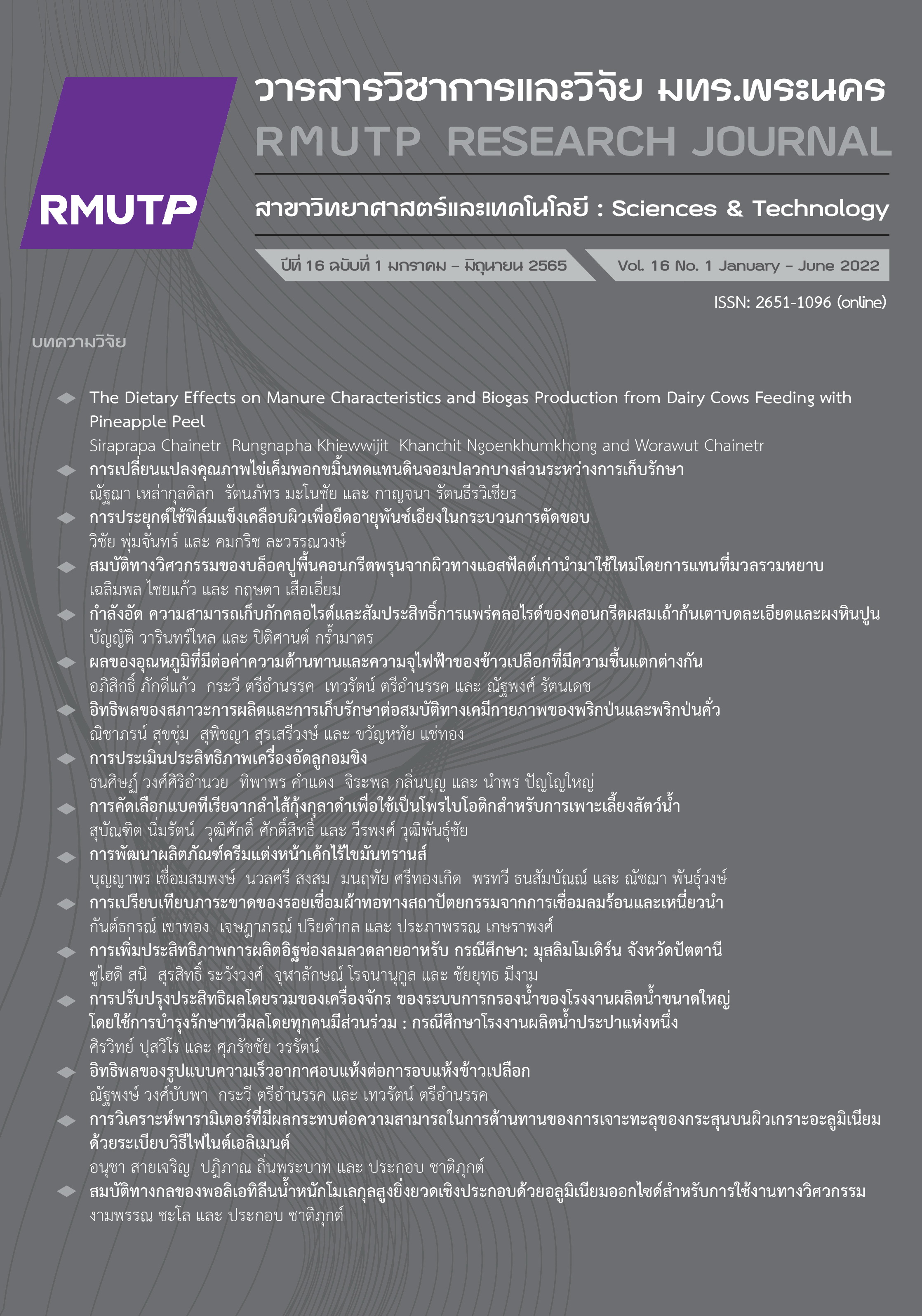การพัฒนาผลิตภัณฑ์ครีมแต่งหน้าเค้กไร้ไขมันทรานส์
Main Article Content
บทคัดย่อ
งานวิจัยครั้งนี้ มีวัตถุประสงค์เพื่อพัฒนาผลิตภัณฑ์ครีมแต่งหน้าเค้กไร้ไขมันทรานส์ การคัดเลือกสูตรครีมแต่งหน้าเค้กพื้นฐาน 3 สูตร โดยผู้ทดสอบ จำนวน 50 คน โดยแบบชิมทดสอบชิม 9- Points Hedonic Scale Test พบว่า สูตรครีมแต่งหน้าเค้กที่มีคะแนนความชอบรวมสูงสุดเท่ากับ 8.37±0.71 คะแนน อยู่ในระดับชอบมากที่สุด ซึ่งประกอบด้วย เนยสด ร้อยละ 36.08 เนยขาว ร้อยละ 15.47 ไข่ขาว ร้อยละ 5.15 น้ำตาลทราย ร้อยละ 25.77 เกลือ ร้อยละ 1.03 น้ำ ร้อยละ 15.47 และ กลิ่นวนิลลา ร้อยละ 10 จากนั้นทดสอบปริมาณทดแทนเนยขาวในสูตรครีมด้วยถั่วขาว ในปริมาณที่แตกต่างกัน 5 ระดับ คือ ร้อยละ 0, 25, 50, 75 และ 100 คัดเลือกสูตรครีม พบว่า ปริมาณการทดแทนเนยขาวด้วยถั่วขาว ที่เหมาะสมในสูตรครีม คือสูตรร้อยละ 100 มีคะแนนความชอบรวม เท่ากับ 8.42±0.75 อยู่ในระดับความชอบมากที่สุด ได้รับการยอมรับจากผู้ทดสอบชิม จำนวน 100 คน โดยมีค่าคะแนนเฉลี่ยสูงสุดเท่ากับ 8.10±0.74 คะแนน ผลิตภัณฑ์มีค่าความสว่าง (L*) เท่ากับ 37.52±0.04 a* เท่ากับ 0.30±0.01 b* เท่ากับ 11.19±0.04 C เท่ากับ 11.20±0.04 และ H เท่ากับ 88.42±0.07 ตามลำดับ ค่าความหนืด เท่ากับ 2857±26.62 cPs ค่าความชื้น ร้อยละ 31.78±0.05 % w.b. และค่าเนื้อสัมผัส ได้แก่ ความแน่นเนื้อ เท่ากับ 55340.06±68.39 g, ความคงตัว เท่ากับ 47,435.10±376.39 นิวตัน และการรวมตัวกัน เท่ากับ 5.30±0.39 g.sec ซึ่งมากกว่าสูตรครีมพื้นฐาน และคุณค่าทางโภชนาการต่อหนึ่งหน่วยบริโภค มีคาร์โบไฮเดรตลดลง 0.19 กรัม พลังงานมากกว่า 32.43 กิโลแคลอรี่ ไขมันลดลง 1.97 กรัม น้ำตาลลดลง 30 กรัม และโปรตีนมากกว่าสูตรครีมพื้นฐาน 0.23 กรัม ซึ่งมีปริมาณเท่ากับ 150 กรัมโดยน้ำหนัก
Article Details

This work is licensed under a Creative Commons Attribution-NonCommercial-NoDerivatives 4.0 International License.
ลิขสิทธ์ ของมหาวิทยาลัยเทคโนโลยีราชมงคลพระนครReferences
K. Nutsaraporn, “Avoid trans fats in food,” M.S. thesis, Dept. Pharmacy, Khon Kaen Univ., Thailand, 2016.
C. Anchan, “Know trans fats,” Academic Journal University of the Thai Chamber of Commerce, vol. 29, no. 4, pp. 124-135, Oct.-Dec. 2009.
S. Hiromi, Stay a hundred years without getting sick, Thailand: SE-EDUCATION, 2013.
P. Pimpen, “Trans fat label,” M.S. thesis, Dept. Food Engineering, King Mongkut's Institute of Technology Ladkrabang Univ., Thailand, 2014.
T. Sumalee, Are trans fats really dangerous. Thailand: Nestle Research Center Switzer- land and the Nestlé Consumer Center, 2015.
I. Boonchai, Conquer serious diseases without drugs, Thailand: Good Health, 2014.
P. Kristi, Eat well, Thailand: Healthy, 2011.
T. Wilasinee, “Characteristics and nutritional value of white bean yogurt,” M.S. thesis, Dept. Economics. Kasetsart Univ., Thailand, 2011.
C. Busarin, “Functional Properties of White Kidney Bean and Its Application of White Kidney Bean Powder in Pastry Products,” M.S. thesis, Dept. Agro-Industry. Kasetsart Univ., Thailand, 2016.
R. Lakkhana, “White Kidney Ban, a wonderful plant on the highlands. Thailand: Kasikorn newspaper, vol. 82, pp. 32-34, 2009.
A. Perera, V. Meda and R.T. Tyler, “Resistant starch: A review of analytical protocols for determining resistant starch and of factors affecting the resistant starch content of foods,” Food Research International, vol. 43, pp. 1959-1974, 2010.
H. Jamlongluk, P. Rungthip and P. Abhisit, Cake Decorating.Thailand: Housekeeper, 2009.
W. Phairoj, Sensory Evaluation, Agro Industry, Thailand: Chiang Mai University, 2002.
D. Jariya, Basic and Applied art of cake decoration, Thailand: House Maid, 1994.
P. Rungthip, Cupcakes 2 new ideas for decorating. Thailand: Housekeeper, 2010.
S. Sai-Ut, S. Ketnawa, P. Chaiwut and S. Rawdkuen, “Biochemical and functional properties of proteins from red kidney bean, navy bean and adzuki beans,” Food Agro-Industry, vol. 2, pp. 493-504, 2009

